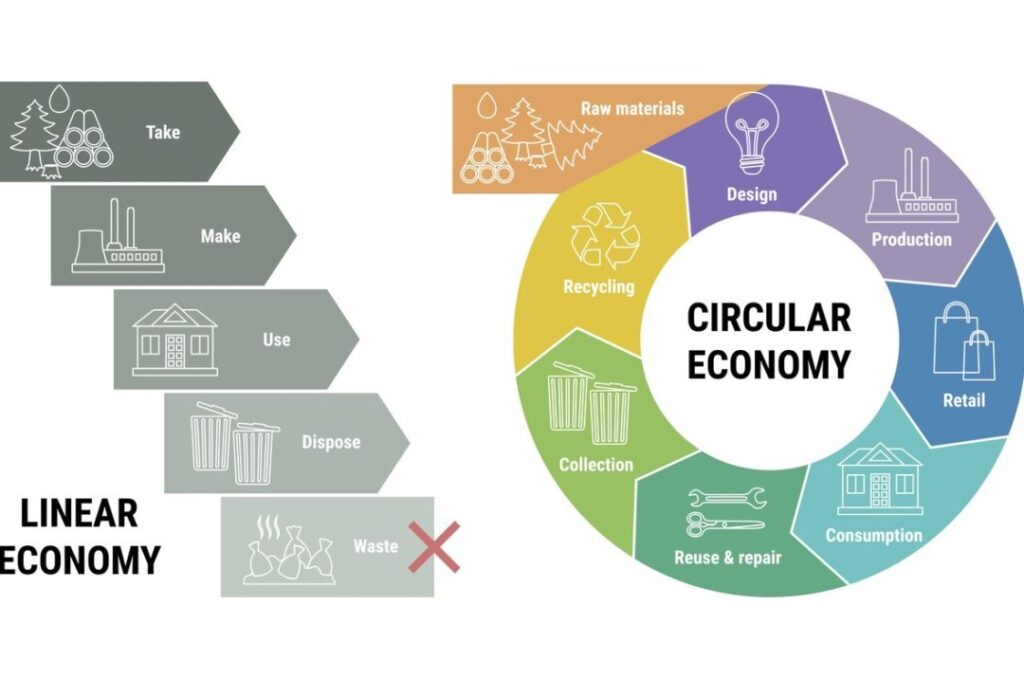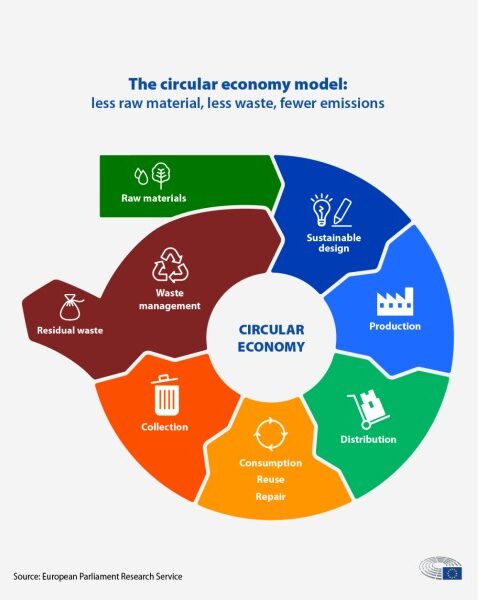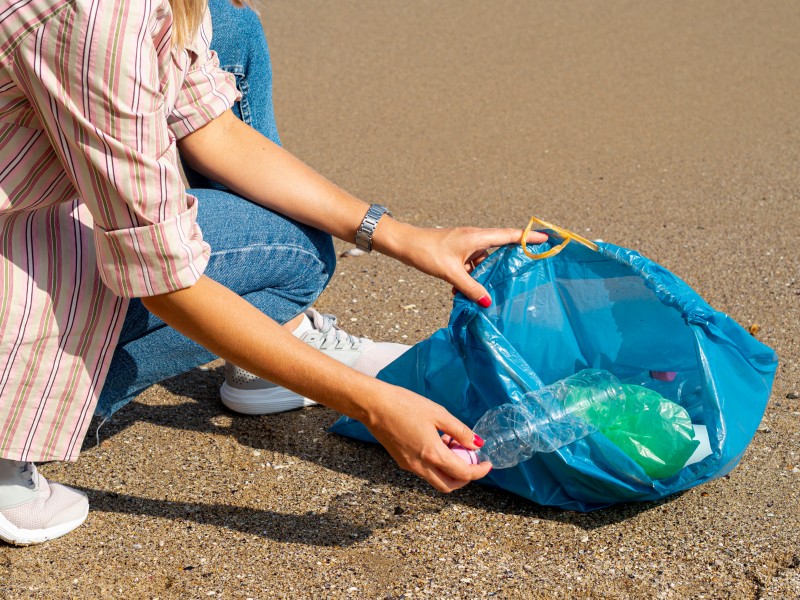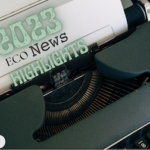Published 19 December 2023 ● Last Updated on 19 December 2023
In this article, we will explore the principles that underscore one of the most promising frameworks in environmental stewardship—the concept of Circular Economy. At the heart of this transformative approach — which aims for a system where nothing is wasted, products and materials are kept in circulation and nature is allowed to regenerate — are the 10 Rs, each representing a fundamental principle guiding businesses and individuals toward a more sustainable and regenerative future.
So, what is circular economy? Simply put, circular economy is a model of production and consumption, which involves sharing, leasing, reusing, repairing, refurbishing and recycling existing materials and products as long as possible. It is glaringly different from the linear economy model which is characterized by a ‘take, make, dispose’ approach. Essentially, the open ended cycle in a linear economy gets “closed” in a circular economy. In the process, all resources used remain within the circle.

A shift from linearity to circularity benefits the environment significantly. In particular, the shift enables Governments to decouple economic growth from higher resource usage and environmental degradation, reducing Greenhouse Gas emissions in the process.
Furthermore, companies who embrace this shift can limit dependencies on the supply chain thus mitigating external risks and minimizing the use of virgin resources. Not only are existing resources used efficiently, cost controls and innovation can occur naturally.

So how do we make the switch to circularity? Let’s take a look at the guiding concepts that form the foundation of this model.
Rethink: The Foundation of Circular Thinking
The first step towards circularity is to challenge and rethink traditional linear models of production and consumption. As mentioned earlier, the rethink principle urges a departure from the linear thinking approach which leads to resource depletion. Instead, it looks towards the circular approach that prompts businesses and individuals to question the status quo and explore alternative models.
Redesign: Prioritizing Longevity and Durability
The principle of redesign stands out as a beacon of change. At its core, redesign challenges the conventional notions of planned obsolescence and disposable consumerism, urging businesses and individuals to prioritize longevity and durability in the products they create and consume. This pivotal shift not only reduces waste, but also contributes significantly to resource conservation and environmental well-being. Several forward-thinking businesses have embraced the redesign principle, demonstrating that sustainability and profitability can go hand in hand. Swedish furniture giant IKEA, has committed to becoming a fully circular business by 2030. Part of their strategy involves designing products that are easy to disassemble and repair, promoting a circular approach to furniture consumption. A recent example of a “redesign” was when under the mandate of the European Union, Apple had to switch the charging ports from Lightning to USB-C in 2023 for its iPhones.

Reduce: Streamlining Consumption for Resource Efficiency
Moving on to the third R, the concept of reducing consumption is about austerity as much as it is about streamlining and optimizing resource use. This principle aims to encourage businesses and individuals to critically examine their patterns of consumption, aiming for a more efficient and responsible utilization of resources in acknowledgment of the finite resources on this planet. The benefits of such a shift are far-reaching, impacting not only environmental sustainability but also economic resilience. Want to know how you can conserve water? Yes, every drop counts.
One business model that has perfectly executed this principle is Airbnb, a platform that promotes resource efficiency by utilizing existing resources more effectively. By facilitating the sharing of accommodations, Airbnb reduces the need for the construction of new hotels, optimizing resource utilization in the hospitality sector.
Repair: Fostering a Culture of Maintenance and Repair
Repairing products contributes directly to the extension of their lifespan. Instead of succumbing to the allure of constant upgrades and replacements, individuals are encouraged to invest in the maintenance and repair of their possessions. Fostering a culture of repair goes beyond individual efforts; it involves building and empowering repair communities. Repair cafes, workshops, and online forums serve as spaces where individuals with varying levels of expertise come together to share knowledge and skills. These communities not only contribute to waste reduction, but also foster a sense of collective responsibility towards the environment.
Recognizing the importance of the ‘Repair’ principle, some regions are pushing for legislation to enforce the right to repair. These policies are important because they ensure that manufacturers provide access to the information, parts, and tools necessary for consumers and independent repair professionals to fix various products. In early 2023, the European Commission passed a law giving consumers a ‘Right to Repair’, both within and beyond the guarantee period. Closer to home, Singapore has a vibrant and upcoming repair scene spearheaded by Repair Kopitiam where repair coaching is done by (skilled) enthusiastic volunteers for electronic appliances and common household items. We have put together a comprehensive list of ‘where to repair’ almost anything in Singapore! Head over hereif are looking for leads.
Reuse: Encouraging Multiple Lifecycles for Products
At the heart of the ‘Reuse’ principle is a fundamental shift from a disposable mindset to one that prioritizes durability. It emphasizes a shift towards items that can withstand the test of time and be upcycled for various applications, thereby extending their lifecycle. One particular brand that has put the concept of reuse to effective use since 1986 is Patagonia. The apparel brand, through its various initiatives such as ‘The Worn Wear Programme’, encourages customers to repair, reuse, and recycle their garments.
Recycle: Closing the Loop on Material Usage
In the grand tapestry of a circular economy, the ‘Recycle’ principle stands as a crucial thread, weaving sustainability into the fabric of production and consumption. At its core, recycling is more than just a waste management strategy — it’s a dynamic process that closes the loop on material usage, transforming discarded items into valuable resources. As we embrace the ‘Recycle’ principle, we not only mitigate the environmental impact of resource extraction but also pave the way for a more sustainable and regenerative future.
Advancements in recycling technologies have expanded the range of materials that can be effectively recycled. From plastics to electronics, innovative processes are continuously being developed to recover valuable resources.
Through its ‘Three Loop Strategy’ consisting of three interrelated initiatives, Adidas has pledged to use its influence in solving plastic pollution. The first loop involves recycling plastic waste, the second involves designing shoes that can be remade and the third loop focuses on regeneration, where Adidas aims to use biodegradable materials that will disintegrate naturally into their surroundings.
Recover: Extracting Value from Waste Materials
In the evolution towards a circular economy, the ‘Recover’ principle is another key driver, redefining the narrative around waste. Instead of viewing discarded materials as liabilities, the ‘Recover’ principle positions them as valuable resources waiting to be unlocked.
A couple of noteworthy initiatives include: Waste-to-Energy energy generation, where non-recyclable waste is converted into heat or electricity in Sweden and in Singapore ; biogas production from organic waste; landfill mining, where useful materials are extracted from older landfill sites, recovering resources that were once considered discarded.
What else is perfect for understanding the concept of Recover? BEACH CLEANUPS!

Refuse: Making Informed Consumer Choices
The ‘Refuse’ principle advocates for a strategic and mindful approach to consumption — making conscious decisions to reject products and practices that contribute to environmental harm. By empowering individuals to say ‘no’ to unsustainable options, the Refuse principle becomes a cornerstone in the foundation of a circular economy.
A significant aspect of the Refuse principle is the rejection of single-use plastics. By refusing items like disposable utensils, straws, and packaging, individuals contribute to the reduction of plastic pollution. This simple act of refusal sends a powerful message to industries about the demand for eco-friendly alternatives and the need for responsible packaging. We discovered the Japanese way of embracing minimalism recently. It is a concept that is fundamentally about reducing consumption
Responsibility: Embracing Extended Producer Responsibility (EPR)
Extended Producer Responsibility is a policy approach that places the onus on manufacturers, importers, and sometimes retailers to manage the entire lifecycle of their products, including post-consumer disposal. This includes designing products for recyclability, establishing collection systems, and ensuring the environmentally sound management of waste. By embracing EPR, producers take ownership of the entire product lifecycle — from design to disposal — fostering a paradigm shift towards responsible and sustainable practices.
Does this ring any bells? The Resource Sustainability Act (RSA) 2019 introduced Southeast Asia’s first Extended Producer Responsibility (EPR) law, passed in Singapore. This holds producers accountable for the responsible disposal of their products once they become waste. The regulation includes:
- Mandatory reporting for companies that produce/use packaging.
- Mandatory 3R plans, including details of the key initiatives, key performance indicators, and targets, which companies will need to track in every report.
Revitalize: Towards a Regenerative Circular Economy
The ultimate goal of the circular economy is to revitalize our planet. By adopting the principles of circularity, we contribute to a regenerative system that supports the health of ecosystems, reduces waste, and ensures a sustainable future for generations to come.
Conclusion
The 10 Rs serve as a roadmap toward a harmonious and sustainable future, where environmental responsibility is not just a goal but a way of life. Together, let’s propel the 10 Rs into action, shaping a future where sustainability is embedded in every aspect of our lives and business practices!
Related Articles



0 Comments